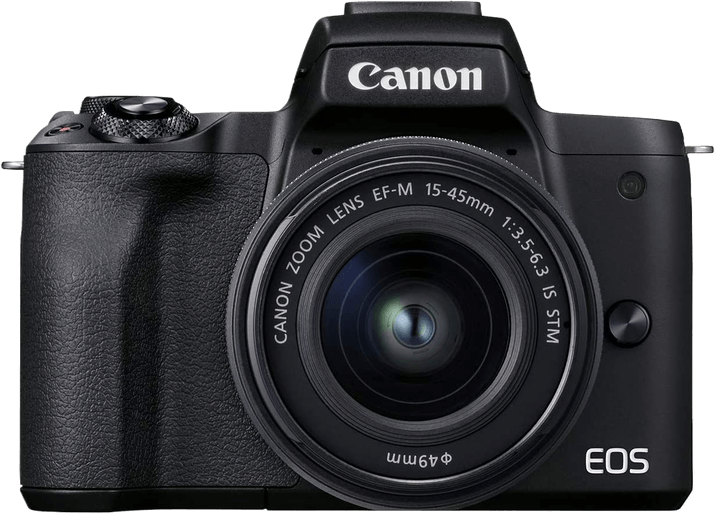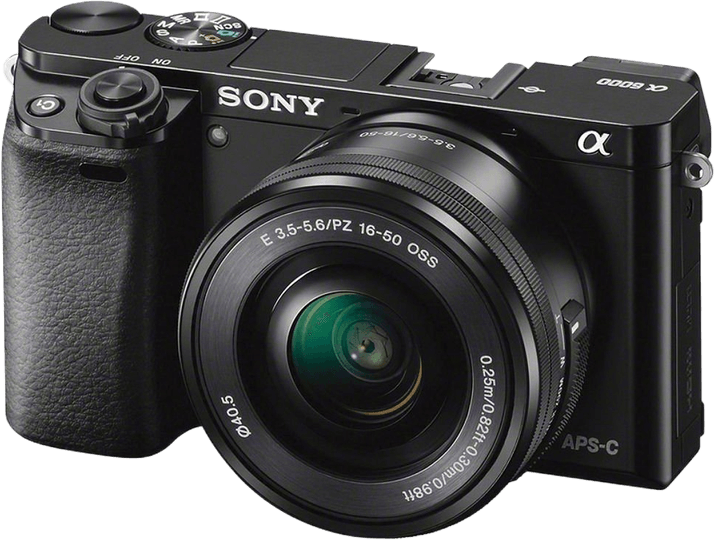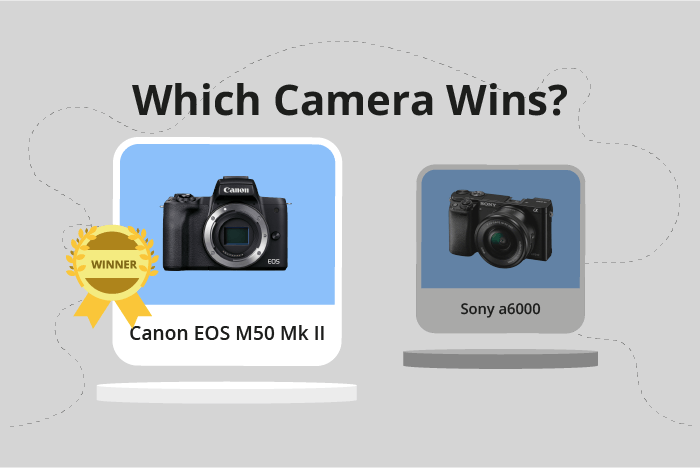Canon EOS M50 Mark II vs Sony a6000 Comparison
Canon EOS M50 Mark II

Sony a6000

The Canon EOS M50 Mark II edges out the Sony a6000 with a score of 59/100 compared to the latter’s 57/100. Both cameras are mirrorless and share similar specs, including their launch prices, with the M50 Mark II at $750 and the a6000 at $799. The M50 Mark II, released in 2020, is a more recent model compared to the a6000 from 2014.
The Canon M50 Mark II has the advantage of being slightly lighter at 387g (0.85lbs) than the Sony a6000 at 344g (0.76lbs). Its dimensions of 116 x 88 x 59mm also make it more compact compared to the a6000’s 120 x 67 x 45mm.
On the other hand, the Sony a6000 is more affordable and has been on the market for a longer time, making it a tried-and-tested option for many photographers. However, the newer Canon EOS M50 Mark II offers better specifications, making it a more attractive option for those looking to upgrade their camera gear.
Canon EOS M50 Mark II vs Sony a6000 Overview and Optics
The Sony a6000 outperforms the Canon EOS M50 Mark II in optics, scoring 67/100 compared to the Canon’s 59/100. Both cameras have 24-megapixel APS-C CMOS sensors, lack image stabilization, and have lens mounts specific to their respective brands (Canon EF-M and Sony E). Despite these similarities, the Sony a6000 has a clear advantage in certain areas.
The Sony a6000 has a slightly higher megapixel count of 24.3, compared to the Canon’s 24. This difference contributes to the Sony’s ability to capture more detail. Additionally, the Sony a6000 has a faster shooting speed of 11 compared to the Canon’s 10, allowing for quicker capture of images in succession. The most significant advantage, however, is the Sony a6000’s DXOMARK score of 82, which is considerably higher than the Canon’s score of 58. This score shows that the Sony a6000’s sensor performs better in areas such as dynamic range, color depth, and low-light performance.
The Canon EOS M50 Mark II, on the other hand, has a more advanced processor, the Digic 8, compared to the Sony a6000’s Bionz X. This newer processor enables faster image processing and potentially better noise reduction. However, the difference in processors does not outweigh the advantages the Sony a6000 offers in terms of optics.
Given these factors, the Sony a6000 emerges as the superior camera in terms of optics. Its higher megapixel count, faster shooting speed, and significantly better sensor performance make it a better choice for those prioritizing image quality. While the Canon EOS M50 Mark II has a more advanced processor, it does not compensate for the gap in optical performance between the two cameras.
Canon EOS M50 Mark II vs Sony a6000 Video Performance
The Canon EOS M50 Mark II outperforms the Sony a6000 in video capabilities with a significantly higher video score of 91/100 compared to the Sony a6000’s 56/100. Analyzing the specifications of both cameras reveals the reasons behind this difference.
Both cameras share some common features, such as the ability to record video. However, the Canon EOS M50 Mark II has superior video quality and features. With a maximum video resolution of 4K (3840 x 2160) and a maximum video frame rate of 120fps, the Canon EOS M50 Mark II offers better image quality and smoother motion capture than the Sony a6000, which has a maximum video resolution of Full HD (1920 x 1080) and a maximum video frame rate of 60fps. Furthermore, the Canon EOS M50 Mark II has a built-in time-lapse functionality, which the Sony a6000 lacks.
While the Sony a6000 has a lower video score and fewer features than the Canon EOS M50 Mark II, it may still be a suitable choice for users who prioritize still photography over video capabilities or have a limited budget. However, its video performance is clearly inferior to that of the Canon EOS M50 Mark II.
Ultimately, the Canon EOS M50 Mark II is the superior camera for videography due to its higher video resolution, faster frame rate, and built-in time-lapse functionality. In contrast, the Sony a6000 may be a more affordable option for those who primarily focus on still photography, but its video capabilities fall short when compared to the Canon EOS M50 Mark II.
Canon EOS M50 Mark II vs Sony a6000 Features and Benefits
The Canon EOS M50 Mark II wins the features comparison with a score of 70/100, while the Sony a6000 scores 41/100. Both cameras have a 3-inch screen, no GPS, and WiFi capabilities. However, the M50 Mark II has a higher screen resolution of 1,040,000 dots compared to the a6000’s 921,600 dots. Furthermore, the M50 Mark II has a touchscreen and Bluetooth, whereas the a6000 lacks these features.
The M50 Mark II’s touchscreen makes it more user-friendly, as it allows for quicker menu navigation and easier focus point selection. Additionally, the Bluetooth connectivity enables seamless photo transfers to compatible devices and remote control of the camera. These features contribute to the M50 Mark II’s higher score and make it a more versatile and convenient camera.
On the other hand, the Sony a6000 does have a flip screen like the M50 Mark II, which is useful for capturing shots from various angles and for vlogging. However, the absence of a touchscreen and Bluetooth puts it at a disadvantage compared to the M50 Mark II.
In comparing the features of the Canon EOS M50 Mark II and the Sony a6000, the M50 Mark II is the superior camera due to its higher screen resolution, touchscreen, and Bluetooth capabilities. The a6000’s flip screen is the only comparable feature, but it is not enough to outweigh the advantages of the M50 Mark II. Therefore, the Canon EOS M50 Mark II is the better choice for photographers seeking a camera with more advanced and convenient features.
Canon EOS M50 Mark II vs Sony a6000 Storage and Battery
The Canon EOS M50 Mark II and Sony a6000 both score 21/100 in storage and battery. They share similarities, such as having a single memory card slot and no USB charging. Both cameras accept SD, SDHC, and SDXC memory cards, but the Sony a6000 also supports Memory Stick Pro Duo and Pro-HG Duo cards.
The Sony a6000 has a slightly better battery life at 360 shots, compared to the Canon EOS M50 Mark II’s 305 shots. This difference makes the Sony a6000 more suitable for extended shooting sessions. However, both cameras use different battery types, with the Sony a6000 using the NP-FW50 battery, and the Canon EOS M50 Mark II using the LP-E12 battery.
Despite the similarities, neither camera outperforms the other significantly in storage and battery. Both cameras have their strengths, with the Sony a6000 having a marginally better battery life and more memory card compatibility. However, these differences are minor and may not be a deciding factor when choosing between the two cameras.
Canon EOS M50 Mark II vs Sony a6000 – Our Verdict
Are you still undecided about which camera is right for you? Have a look at these popular comparisons that feature the Canon EOS M50 Mark II or the Sony a6000:

